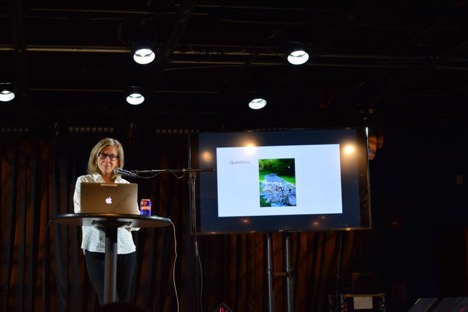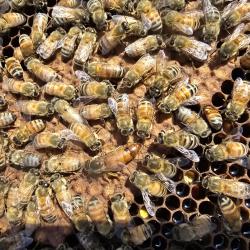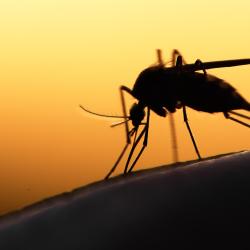Science on Tap Lecture at UMD Explains How Blowing Up Mountains for Coal is “Obliterating Ecosystems”
A single phone call 14 years ago began Margaret A. Palmer’s journey down a path that resulted in her being center stage in federal trials, where she testified about the science associated with the environmental impacts of mountaintop coal mining.
 Many argue that mining jobs are essential and environmental impacts of mountaintop removal could be mitigated by improving and creating streams; however, neither of these claims is currently supported by science, according to Palmer.
Many argue that mining jobs are essential and environmental impacts of mountaintop removal could be mitigated by improving and creating streams; however, neither of these claims is currently supported by science, according to Palmer.
A Distinguished University Professor of Entomology and director of the National Socio-Environmental Synthesis Center (SESYNC), Palmer spoke on this topic on Nov. 4, 2019, at the Science on Tap lecture series hosted each month at MilkBoy ArtHouse by the University of Maryland’s College of Computer, Mathematical, and Natural Sciences.
“At the time I got that call…I knew something about the Clean Water Act and how it related to restoration, but nothing in very much depth about [mountaintop removal for coal mining],” Palmer said. “I certainly knew nothing about being in a courtroom or about litigation.”
Her extensive research on environmental impacts of mountaintop coal mining thereafter led her to testify before Congress and even be invited to appear on political satirist Stephen Colbert’s talk show “The Colbert Report.”
“We had actually gone over some of Margaret Palmer’s work in one of my biology classes and my professor spoke very highly of her,” said Erica Long, a senior biological sciences major specializing in ecology and evolution. “So I was interested in coming to this event and hearing her talk.”
While Palmer shared a bit about her experiences on the talk show and in the courtroom, her lecture focused on the key points of the science surrounding this issue.
According to Palmer, mountaintop coal mining is “obliterating ecosystems” at two different levels. It destroys Appalachian forests and nearby streams. Not only do the coal companies cut down the forests often for additional funds, the forests are also cut down to allow room for the massive pieces of machinery used to shove the excess rock, soil and other material produced by blowing up the mountain ridge down into the mountain valleys and streams below. The piles of broken rocks and soil are called overburden.
Coal companies do this because it is cheaper to fill up valleys and “restore” streams than to load trucks and transport the overburden to another location.
“If you look at the amount of land that’s disturbed with respect to how much coal is actually produced from that, there’s a huge disparity,” Palmer added. The square meters of land disturbed per metric ton of coal mined has gone up exponentially, particularly since 2010.
Deforestation and land disturbance has decreased the diversity of vegetation and forms of life in the Appalachian mountains, which are known as a major biodiversity “hot spot” in the United States, but the impact is worse in the mountains’ streams, Palmer said.
Many of the headwaters for Appalachian mountain streams are born in the valleys, and water from these streams--now contaminated and filled with overburden--move downstream into stream networks that are not filled with overburden. The streams eventually connect to large river networks, which degrade with these contaminants.
The coal companies make up for these negative environmental impacts by creating new streams that are considered complete and “fully reclaimed,” which means “[the coal companies] have done what they are required to do by law to return it to a more natural setting,” said Palmer. But according to Palmer’s research, some of the streams that are “created” to mitigate for impacts are essentially drainage ditches from the mine site and bear little resemblance to the streams that were destroyed. The water is highly polluted and often discolored. Some “restored” or “created” streams flow with orange-colored water, and some are somewhat milky-colored, according to photos taken by Palmer, which she presented in her lecture. Others that look relatively clear are deceiving in appearance—their chemistry is actually toxic to many aquatic organisms.
Minerals deposited in these restored streams can coat leaves, which litter the streambed floor, in such a way “that you can pick up the leaf and it would break in your hand,” Palmer said.
The reason: the rock material that is blown up, the overburden, has not been exposed to water and oxygen for a very long period of time, perhaps for more than 300 million years.
“When the streams are exposed to runoff from rainwater and oxygen permeating the overburden, it results in a chemical process in which a lot of ions are put into the water that would not normally be in those streams,” Palmer explained. “What that does is to bring into solution from the rocks, all these ions from— carbonate, calcium, sulfate, magnesium, selenium, manganese…This goes into the solution and creates essentially a toxic soup.”
Many of the minerals in low concentrations or by themselves are not toxic; however, combined, they create conditions “that can interfere with the organisms’ inability to osmoregulate,” said Palmer, referring to a process involving the organism's ability to maintain the salt and water balance (osmotic balance) across membranes within its body.
Many aquatic insects like mayflies and stone flies, which are the base of the food web, were the first to be lost in these Appalachian streams due to this contamination, and fish have been found with severe spinal deformities, two heads, two eyes on one side of the head, or an inability to reproduce.
Palmer spoke about an idea Colbert brought up during her segment on his show: Why not use giant Brita water filters to filter the streams? The idea is an interesting one, Palmer said, however, “It turns out that that’s essentially impossible to do. The hydrology is fundamentally changed when the valley is filled.”
The soil at the top of the mountain where the mining occurs is too compact and does not allow rainwater to percolate through the soil and infiltrate the soil layers; rather, the rain water runs off the top and into the valley fill that is highly porous. The water is not captured by a single outlet but can move laterally once it gets to the stream because of all the loose rocks and soil that were pushed into the valley.
In addition to mountaintop coal mining’s environmental impacts, Palmer said the practice has socio-economic impacts as well.
“It’s a common myth that mining is creating a lot of jobs,” Palmer said.
However, for years even before the Obama administration, the number of jobs available for coal miners has seen a gradual steep decline.
“This is largely because large machinery can replace 30 or 40 coal miners,” Palmer said. “They’re not going underground and not taking coal. It’s very mechanized.”
The most recent data show that one of the biggest reasons the coal industry is in decline is related to the natural gas availability in the United States, according to Palmer. The coal industry has survived by exporting a majority of what it produces to other countries like China, but exports have been declining very quickly in the last six months because of the new U.S. policies on exports and export taxes.
“For example, Russia is now exporting coal to China instead of the U.S.,” Palmer said.
While Palmer’s lecture focused on mountaintop coal mining on American soil, some audience members wondered whether these issues also occurred in other countries.
“Are these practices practiced in other parts of the world? And how are the policymakers there responding?” asked James Alexander, a University of Maryland professor emeritus of mathematics and regular attendee of Science on Tap.
Unfortunately, similar practices are happening around the world, particularly in developing countries “where there tend to be no [policies at all or they] very much lack policies related to it,” Palmer said.
###
Media Relations Contact: Abby Robinson, 301-405-5845, abbyr@umd.edu
Writer: Nicolle Schorchit
University of Maryland
College of Computer, Mathematical, and Natural Sciences
2300 Symons Hall
College Park, MD 20742
www.cmns.umd.edu
@UMDscience
About the College of Computer, Mathematical, and Natural Sciences
The College of Computer, Mathematical, and Natural Sciences at the University of Maryland educates more than 9,000 future scientific leaders in its undergraduate and graduate programs each year. The college’s 10 departments and more than a dozen interdisciplinary research centers foster scientific discovery with annual sponsored research funding exceeding $175 million.







